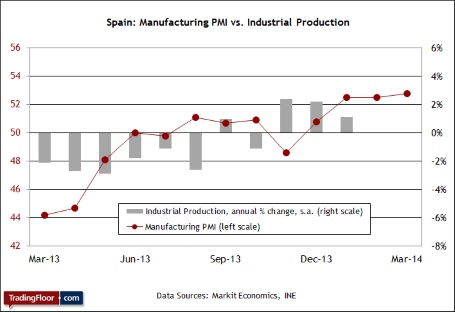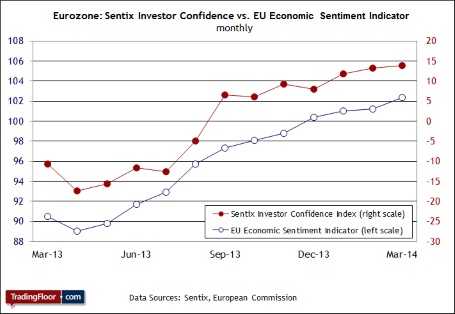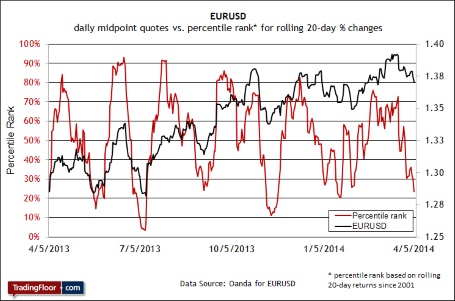Monday is a light day for scheduled economic reports, although the February release on industrial production for Spain will provide a timely update on how the country’s mild recovery is holding up in the face of what may be rising deflation risk for the Eurozone. We’ll also see fresh intelligence on how the mood in Europe is faring with the monthly data for the Sentix Investor Confidence Index. Meanwhile, keep a close eye on EURUSD in the wake of the European Central Bank’s questionable decision last week to forgo monetary action as inflation's pace decelerates. Don’t forget that Germany also publishes new industrial production numbers at 06:00 GMT.
Spain Industrial Production (07:00 GMT): Several recent economic updates suggest that Europe’s fourth-largest economy is on the mend. The manufacturing sector, for instance, posted “solid output growth” last month, according to last week’s update of the Markit Spain Manufacturing Purchasing Managers Index (PMI). Meanwhile, the number of registered unemployed workers in Spain fell in March at the steepest rate in eight years. Although the country still faces enormous challenges—a sky-high 26 percent jobless rate, for starters—there are enticing signs on the margins that the macro tide is turning positive. The question is whether the general climate in the Eurozone will continue to encourage progress and allow Spain to build on its precarious recovery.
There are new doubts after the European Central Bank (ECB) decided to talk rather than act last week in the face of what appears to be an increasing threat of deflation. “The ECB is playing with fire by failing to act,” a former IMF executive warned. “Europe faces an extremely serious problem and the window is basically closing for the peripheral economies. The inflation rate in Italy and Spain is now so low that it calls into question their ability to service their sovereign debts. They need two percent inflation to make it.”
By that standard, the central bank needs to do more than talk about what it could do—Eurozone consumer inflation is just 0.5 percent in year-over-year terms while Spain’s rate is just a touch over zero. Meantime, the potential for even lower inflation and perhaps outright deflation threatens the limited progress of repair and recovery in the “peripheral economies.” It’s unclear how much risk hangs over Spain, in part because of uncertainty over what the ECB will do and when.
For now, it’s important to monitor how the mild rebound is holding up. Today’s report on industrial activity will offer a valuable clue. The recent trend has been encouraging: the year-over-year pace in industrial production for Spain has posted increases in each of the past three monthly releases. But the gains have been slipping, with January’s rise dipping to 1.1 percent in seasonally adjusted terms. Is this an early warning that the country’s rebound is weaker than the crowd assumed? We'll know more after today's numbers arrive.

EU Sentix Investor Confidence Index (08:30 GMT): Worrying about deflation is the new new risk factor in Europe, again, in part because the European Central Bank continues to dismiss such fears. Although the bank hinted at the possibility of rolling out so-called unconventional monetary measures at last week’s policy announcement, the status quo prevails for now. But the ongoing slide in the annual rate of consumer price inflation, along with outright deflation in industrial prices, suggests that the hour is late and the window for productive action is closing.
If a tipping point is near, we might see the change by way of a sharp drop in investor sentiment. So far, however, the market’s general mood has been resilient. For instance, two sentiment measures for Europe have been trending higher since mid-2013. In the previous monthly updates for March, the Sentix Investor Confidence Index and the EU’s Economic Sentiment Indicator inched higher. Meanwhile, Markit’s survey data for manufacturing also points to a brighter outlook lately for Europe. Keep in mind, however, that there’s been some mild deterioration in Germany, based on the ZEW Indicator of Economic Sentiment. This widely followed index has been soft through this year’s first quarter after last year’s strong gains. If that’s a sign of trouble for sentiment generally in the months to come, the broader yardsticks of the mood in Europe will soon pick up on the shift.
It wouldn’t be surprising to see some weakness in today’s Sentix update. A hefty drop would surely be a dark sign given the heightened concern about deflation and the ongoing potential for macro trouble related to blowback from the smouldering Russia-Ukraine crisis. The issue now, as The Economist noted, is “a concern that the recovery may have come too late and be too weak to avert the onset of deflation.” An early warning on that front would likely show up in sentiment data, and so today’s April release deserves close attention for deciding how, or if, the mood is changing.

EURUSD: The European Central Bank (ECB) tells us that it’s willing, in theory, to do more to combat deflation risk, although in practice the central bank is still sitting on its hands. But its new-found willingness to talk up the possibility of a quantitative easing program may be a back-door strategy for devaluing the euro, which will be critical if deflation risk is in fact rising, as it seems to be. This much is clear: EURUSD’s rally ended in late-March and bearish momentum has been accelerating. Whether this reflects official policy, the market’s evolving outlook for the Eurozone, or both, there’s no denying that the tide has turned.
Some of the reversal is simply the natural effects of financial gravity. As the chart below reminds us, the recent peak for EURUSD at around 1.39 was accompanied by short-term price momentum that ranked relatively high in terms of the percentile rank for rolling 20-day returns. “We continue to believe that the ECB is running unnecessary risks in its slow response to low inflation and expect non-conventional monetary easing measures before year-end,” according to Barclays Capital in a research note late last week. Apparently the forex market agrees, or so the latest decline in EURUSD suggests. Adding to the selling pressure is Friday’s upbeat news on US non-farm payrolls for March—news that some interpret as a sign that the US economic growth will quicken in the spring and thereby boost the bullish outlook for the US dollar.
In any case, the euro will be under renewed pressure with the potential for new policy action from the ECB lurking around the corner. As a tactical matter, however, the downside momentum may be due for a break. The percentile rank for the 20-day return window is now at a two-month low.
